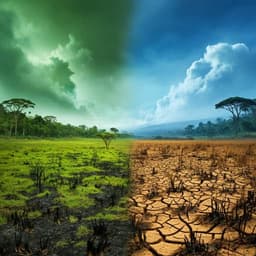
Earth Sciences
Fire decline in dry tropical ecosystems enhances decadal land carbon sink
Y. Yin, A. A. Bloom, et al.
Discover how a decline in global fire emissions contributed to a significant increase in terrestrial carbon sinks, a key insight brought to you by researchers such as Yi Yin and his team from the California Institute of Technology. This enlightening study reveals overlooked mechanisms that may transform our understanding of climate mitigation strategies.
Playback language: English
Introduction
Fire is a crucial disturbance in terrestrial ecosystems, especially dry tropical regions, closely linked to vegetation, climate, biogeochemical cycles, and human activities. Climate significantly influences fire by controlling fuel load and conditions for ignition and spread. However, human activities, responsible for most ignitions and suppression efforts, profoundly impact fire's timing, frequency, extent, and intensity. Recent decades have seen a transition from natural to human-dominated fire regimes due to population growth and agricultural expansion. A global decline in burned area (BA) of 25% from 1997 to 2015 has been observed, largely in African savannas, correlated with agricultural expansion and landscape fragmentation. Concurrently, the airborne fraction of anthropogenic CO2 emissions decreased (–2.2% per year, 2002–2014), despite increasing emissions. Explanations for the increased terrestrial carbon sink remain debated, involving CO2 fertilization, changing soil moisture and temperature, and land-use change. The Global Carbon Project (GCP) synthesis reveals a budget imbalance requiring an additional sink of ~0.6 PgC per year to explain the observed airborne fraction in the last decade. While direct fire carbon emissions are considered in global carbon budgets, the impact of wildfire decline on subsequent ecosystem carbon cycling hasn't been well-quantified. Under dynamic equilibrium, fire's net effect on the long-term carbon budget is negligible; however, fire regime shifts can cause long-term carbon loss or gain. This study aims to estimate changes in the land carbon sink attributable to the observed global BA decline over the last decade due to both direct (fuel combustion) and indirect (post-fire ecosystem carbon cycle) impacts.
Literature Review
Previous research has established the significant role of fire in terrestrial carbon cycling, particularly in the tropics. Studies have highlighted the influence of climate on fire regimes, affecting fuel load and fire spread (Marlon et al., 2013; van der Werf et al., 2008; van der Werf et al., 2008). The impact of human activities on fire regimes, both through increased ignition frequency and altered fuel loads, has also been well-documented (Pechony & Shindell, 2010; Archibald et al., 2013; Bowman et al., 2009). A substantial decline in global burned area has been observed in recent years (Andela et al., 2017), linked to agricultural expansion and landscape fragmentation (Zubkova et al., 2019). The observed decrease in the airborne fraction of CO2 (Keenan et al., 2016) has spurred research into enhanced terrestrial carbon uptake, with potential explanations including CO2 fertilization, changes in soil moisture and temperature, and land use change (Schimel et al., 2015; Ballantyne et al., 2017; Piao et al., 2018). The Global Carbon Project has synthesized these various estimates, revealing a persistent budget imbalance (Le Quéré et al., 2018), pointing to the need for further investigation into missing carbon sinks. While the direct emissions from fires are typically accounted for in carbon budgets (Liu et al., 2017; Yin et al., 2016), the indirect effects of fire decline on the ecosystem carbon cycle have not been fully explored. Studies examining the impact of fire on long-term carbon storage (Kashian et al., 2006; Luo & Weng, 2011) have hinted at the potential significance of fire regime shifts, but quantitative analyses of the impact of recent fire declines on the global carbon budget have been lacking.
Methodology
This study used the CARbon DAta-MOdel fraMework (CARDAMOM), constrained by atmospheric and land-surface carbon observations from 2001–2014, to estimate the impacts of fire decline on the terrestrial carbon cycle. CARDAMOM incorporates six carbon pools (foliar, labile, wood, fine roots, litter, and soil carbon) and simulates the dynamics of these pools, incorporating processes like gross primary production (GPP), autotrophic respiration (Ra), net primary production (NPP), and decomposition (Rh). Fire is represented through satellite-derived burned area (BA) data, influencing biomass combustion and mortality rates. The model was constrained by multiple datasets including fire carbon emissions inferred from atmospheric CO inversions (MOPITT), satellite-derived observations of leaf area index (LAI), GPP variability from solar-induced fluorescence (SIF), above-ground biomass, and soil organic carbon data. The study used two BA datasets: GFED4 (based on surface reflectance changes) and GFED4s (including small fires detected by thermal anomalies). CARDAMOM optimized key carbon cycle and fire-related parameters using a Bayesian model-data fusion approach. First, the model estimated fire carbon emissions from 2001–2014. Then, to assess the impact of the observed BA decline, sensitivity simulations were performed using a control run with a constant BA based on the 2001–2007 average. The differences between the observation-retrieved carbon cycle states and fluxes (Observed BA) and the control run (Fixed BA) represent the impacts of the BA decline. The study also used atmospheric top-down fire emissions estimates from MOPITT CO inversions combined with biome-specific emission ratios between CO and total carbon to provide additional constraints and assess the robustness of the findings. Finally, the study integrated its findings on changes in fire emissions (ΔFIRE) and net ecosystem exchange (ΔNEE) into the Global Carbon Project's framework to estimate the effect of fire decline on the airborne fraction of CO2.
Key Findings
Global burned area decreased significantly between 2001–2007 and 2008–2014, primarily in savannas, woody savannas, and grasslands. CARDAMOM estimates show a decline of 0.2 ± 0.1 PgC per year in fire emissions during 2008–2014 compared to 2001–2007. This fire decline resulted in an additional carbon sink enhancement of 0.4 ± 0.2 PgC per year due to carbon cycle feedbacks. The indirect effect of fire decline on net ecosystem exchange (NEE) was roughly twice the magnitude of the direct impact on fire emissions. The increase in GPP, leading to the enhanced carbon sink, was largely attributed to regions with significant fire emission reductions (Sahel region in North Africa and dry sub-tropics in South America). Positive trends in vegetation indices in these areas supported this finding. The simulated gains in above-ground biomass following fire reduction were consistent with site-level observations in tropical savanna ecosystems. Incorporating the estimated impacts of fire decline into the Global Carbon Project's carbon budget significantly reduced the mean bias and root mean square error of the initial estimates, suggesting that fire reduction played a substantial role in the recent increase in the terrestrial carbon sink. The legacy effects of the reduced fire activity between 2008-2014 continued to be observed beyond this period, with a gradual decline in the positive impact on NEE over the following years, though the effects remained significant even after a decade.
Discussion
The findings address the research question by quantifying the contribution of fire decline to the increased terrestrial carbon sink observed in recent decades. The study demonstrates that the indirect effects of reduced fire activity, through enhanced plant growth and reduced ecosystem respiration, are substantial and should not be overlooked. The results highlight the importance of considering these indirect effects when evaluating the global carbon budget and projecting future carbon-climate feedbacks. The significant reduction in the mean bias and RMS error of the Global Carbon Project's estimates when incorporating the fire decline impacts suggests that this mechanism plays a role comparable in magnitude to other commonly considered factors like CO2 fertilization and land-use change. The regional patterns observed, particularly the strong response in dry tropical regions, suggest a geographically concentrated impact of fire reduction on carbon sequestration. The study's findings have implications for climate change mitigation strategies, emphasizing the importance of fire management practices in enhancing terrestrial carbon storage.
Conclusion
This study demonstrates that the decline in global fire activity between 2008 and 2014 led to a significant enhancement of the terrestrial carbon sink, exceeding the direct reduction in fire emissions. The indirect effects, operating through changes in GPP and ecosystem respiration, were crucial in this enhancement. The results highlight the importance of considering these indirect effects in global carbon cycle modeling and underscore the role of fire management in climate change mitigation. Future research should focus on improving the representation of fire-ecosystem interactions in Earth System Models and investigating the long-term effects of sustained fire reduction on carbon cycling, especially considering potential changes in climate patterns and their effects on fire regimes.
Limitations
The study focused on the period 2001–2014, limiting the assessment of long-term impacts of fire decline. The legacy effects of fire activity before 2007 are implicitly included but not explicitly addressed. The model does not explicitly account for nutrient limitations or grazing impacts, potentially overestimating the GPP enhancement due to reduced fire. Future research should investigate the role of model structural uncertainties in addition to parametric uncertainties.
Related Publications
Explore these studies to deepen your understanding of the subject.







